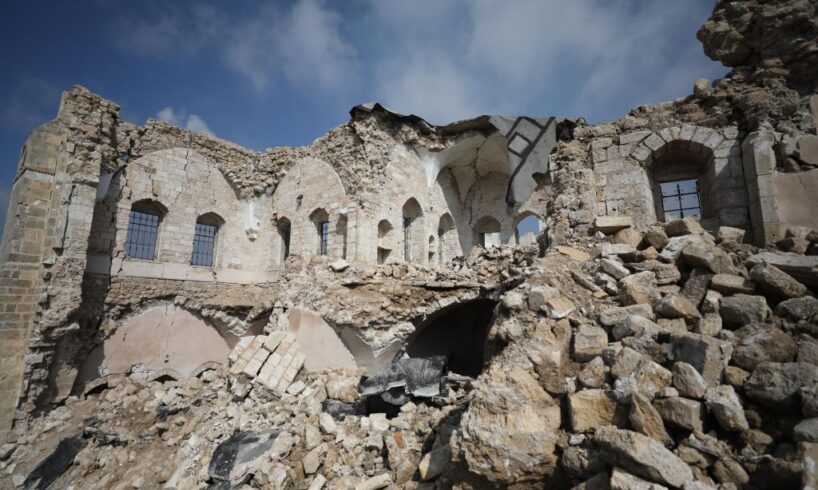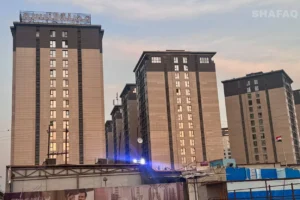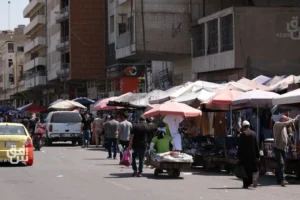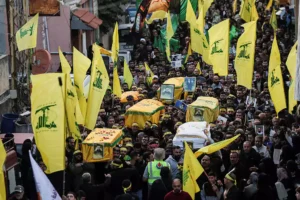
Shafaq News
Beneath Gaza’s modern streets and rubble lie
fragments of civilizations that shaped the region for millennia. Yet the
ongoing Israeli war since October 7, 2023, has shattered much of this heritage,
threatening to erase irreplaceable cultural landmarks that reflect Gaza’s
complex history.
Among the most significant sites affected is the
Saint Hilarion Monastery near Deir al-Balah. This complex, dating back to the
4th century CE, once served as a major Christian monastic center in the Levant.
Archaeologists have documented its basilica,
cloister, baptistery, and burial crypts, all of which have sustained
considerable structural damage amid the fighting.
Previously placed on UNESCO’s World Heritage
Tentative List, the monastery was officially designated as endangered in early
2024.
Northwest of Gaza City, the remnants of Anthedon
Harbour—a vital ancient port spanning eras from the Iron Age to Hellenistic
times—now bear the marks of bombardment. Multiple airstrikes between late 2023
and early 2024 left craters and scattered debris, as confirmed by satellite
images analyzed by UNOSAT. These blows risk obliterating the layers of history
embedded in the site’s stones.
Jabaliya, a town in northern Gaza, was home to a
recently discovered Roman-era necropolis called Ard al-Moharbeen. Revealed in
2022 and 2023 during construction activities, the site contained more than 125
tombs, including rare lead sarcophagi—finds of considerable archaeological
value. Reports indicate that the necropolis was nearly completely destroyed
during a ground incursion in late 2023.
The historic core of Gaza City has also suffered.
The Pasha Palace, an Ottoman-era administrative building turned museum, lies in
ruins after repeated strikes in early 2024. The palace’s intricately tiled
halls and arches, once admired for their craftsmanship, are buried beneath
collapsed walls.
Similarly, Hamam al-Sammara—the last functioning
traditional bathhouse in Gaza and a structure with over 700 years of continuous
use—was destroyed by an airstrike. Nearby, the Qissariya Market, with its
vaulted stone corridors dating back to the Mamluk period, partially collapsed
under bombardment.
Among Gaza’s religious landmarks, the Great Omari
Mosque sustained heavy damage in December 2023. Built atop a Byzantine church
and reconstructed during the Mamluk and Ottoman eras, the mosque’s northern
wall, dome, and main prayer hall were reduced to rubble, signaling a profound
loss for both worshippers and heritage conservationists.
The Greek Orthodox Church of Saint Porphyrius,
located in the Zaytoun district, have also suffered a particularly tragic blow
on October 19, 2023. While sheltering displaced families during the fighting,
the adjacent monastery buildings were struck by a blast that killed at least 18
civilians, including women and children, and injured many others. Although the
church’s bell tower remained intact, much of the surrounding complex was
severely damaged.
Saving what’s Left
International law provides protections for cultural
heritage sites regardless of their use, a point UNESCO has emphasized
throughout the conflict. The agency cites the 1954 Hague Convention for the
Protection of Cultural Property and Protocol I of the Geneva Conventions, both
of which prohibit targeting cultural property unless absolutely necessary for
military operations.
This widespread damage has drawn concern from
global heritage organizations. ICOMOS, which advises UNESCO, has placed Gaza’s
historical fabric on its emergency watch list. Likewise, the World Monuments
Fund included Gaza’s Old City on its 2025 list of the world’s most endangered
cultural heritage sites, underlining the vulnerability of the enclave’s
historic urban environment.
The financial toll is also substantial. In a report
released in January 2024, the World Bank estimated losses to Gaza’s cultural
sector at over $319 million. This encompasses destruction of museums,
archaeological sites, historic neighborhoods, and religious monuments.
According to Gaza’s Ministry of Culture, at least
247 cultural institutions, including libraries, theaters, and heritage centers,
have been destroyed or damaged. Independent assessments by ALIPH and ICOMOS
also suggest that over 1,000 historical artifacts may be irretrievably lost.
Local officials further estimate that upwards of
60% of Gaza’s cultural assets have been directly affected since hostilities began,
while heritage-related livelihoods—craftspeople, tour guides, and preservation
workers—have seen a 90% drop in activity and income.
Amid this devastation, efforts to protect what
remains have begun. The ALIPH Foundation has supported salvage operations aimed
at recovering artifacts from collapsed buildings, including museum collections
from the Pasha Palace. Archaeologists based in Gaza, led remotely by researcher
Fadel al-Utol, are also employing mobile technology and digital tools to
document damage and preserve records of threatened sites.
Moreover, UNESCO has committed to backing
comprehensive assessment and restoration once conditions permit safe access.
However, experts caution that rebuilding Gaza’s cultural heritage will be a
long-term, costly endeavor, with estimates suggesting several hundred million
dollars and years of dedicated work will be required to restore what has been
lost.
Written and edited by Shafaq News staff.





